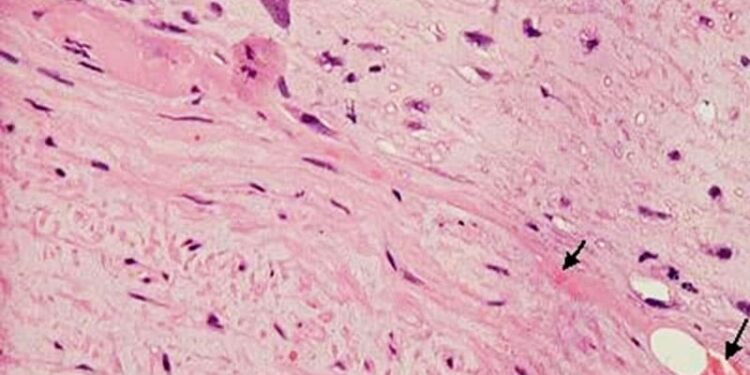Artificial intelligence can detect cardiac amyloidosis from a short video of a heartbeat, according to new research in the European Heart Journal.
Cardiac amyloidosis results when misshaped or misfolded proteins lodge throughout the heart, forcing it to work harder to pump blood. The condition can lead to thicker heart walls, is more common in older adults, and has features similar to those of hypertensive heart disease or aortic stenosis.
Diagnosis is challenging, particularly in earlier disease stages, when thicker heart walls are not apparent on an echocardiogram.
“If the patient has symptoms we can’t explain and if the echo isn’t quite normal, it would be reasonable to apply this AI model to see if they have amyloid,” said Patricia Pellikka, MD, the Betty Knight Scripps Professor of Cardiovascular Disease Clinical Research at Mayo Clinic in Rochester, Minnesota, and a co-author of the new study. Those symptoms could be nonspecific, such as shortness of breath, fatigue, or swollen ankles, Pellikka said.
Cardiac amyloidosis is definitively diagnosed with a biopsy or blood and urine analysis. Although rare, the number of cases appears to be rising. The prevalence rate rose from 8 to 17 per 100,000 person-years from 2000 to 2012, according to an analysis published in Circulation: Heart Failure. A 2025 analysis by researchers at Mayo Clinic found an overall prevalence of cardiac amyloidosis of 1.25% among more than 30,000 people who received an echocardiogram, with a greater incidence in people aged 80-89 years than among those aged 60-69.
“Delays in diagnosis are very common with this disease,” said Jeremy Slivnick, MD, a cardiologist at the University of Chicago who helped conduct the latest research. In many cases, a year or more will elapse between the first appearance of symptoms and a diagnosis of amyloidosis, at which point the disease is harder to control, he said.
Comparing AI to Other CA Screening Tools
The new study validates previous research that led to the 2024 approval of the technology — EchoGo Amyloidosis — in the United States on a diverse population that spanned 18 global research sites. And the research shows that the AI model has broad applicability, Slivnick added.
““This is now an FDA-approved product,” Slivnick said. “It’s really critical that it works on everyone.”
Pellikka and her colleagues at Mayo previously worked with Ultromics, the Oxford, UK-based biotech firm that markets EchoGo Amyloidosis, to create an AI algorithm that distinguishes cardiac amyloidosis from other types of heart disease. They fed video clips of echocardiograms of people diagnosed with the disorder into the tool, as well as video clips of people with other heart conditions. These clips showed the heart’s four chambers during heartbeats.
The new retrospective study tested the AI tool at 18 global sites, with 597 echo videos of people with cardiac amyloidosis and 2122 videos of people with other heart conditions.
The AI model effectively spotted all subtypes of amyloidosis in the dataset, with an area under the receiver-operating characteristic curve (AUROC) of 0.93, a sensitivity of 85% for identifying patients with the condition, and a specificity of 93% for finding those without the disorder.
An apical four-chamber view of a patient with newly diagnosed hereditary ATTR amyloidosis. The patient had presented with heart failure with preserved ejection fraction. This videoclip was among those used to build the model. Video courtesy of Mayo Clinic/Ultromics
Compared with other commonly used diagnostic tests for the condition, including concentrations of transthyretin (which can form amyloid deposits) and measurements of cardiac wall thickness, the AI model spotted more cases of concern. The AUROC for the AI model was 0,93, compared to an AUROC of 0.73 for transthyretin concentration and an AUROC of 0.80 for increased mediation.
“Now we’ve got therapies for amyloid cardiomyopathy, but they work best if they’re applied early in the natural history of the disease. We should be getting people on the treatment they need,” Pellikka said.
Several options exist. The FDA has approved three drugs for the treatment of cardiac amyloidosis, each of which can stop further production of amyloid deposits but do not reverse the damage already done. These drugs are tafamidis (Vyndamax), acoramidis (Attruby), and vutrisiran (Amvuttra).
Amyloidosis “is a progressive disease. As of now we don’t have anything to reverse the pathology, so the more protein that deposits in the heart, the worse these patients do,” said David Snipelisky, MD, an advanced heart failure and transplant cardiologist at Cleveland Clinic in Weston, Florida. Heart transplants are sometimes an option, Snipelisky said, but in other cases only the medications meant to stop amyloid production are possible.
Representatives of any echo lab can upload video clips of suspected cases of cardiac amyloidosis to a secure site maintained by the company, Pellikka said, and receive a result of whether amyloidosis is likely, unlikely, or indeterminate.
Although the latest findings show the potential of the algorithm to diagnose cardiac amyloidosis from a single echo image, the next step would be test the tool in a prospective clinical trial, Snipelisky said.
Snipelisky reported no relevant financial conflicts of interest. Slivnick reported relationships with GE Healthcare, Pfizer, and BridgeBio. Pellikka reported funding from the National Institutes of Health, Ultromics, and Edwards Lifesciences.
Marcus A. Banks, MA, is a journalist based near New York City who covers health news with a focus on new cancer research. His work appears in Medscape, Cancer Today, The Scientist, Gastroenterology & Endoscopy News, Slate, TCTMD, and Spectrum.
Source link : https://www.medscape.com/viewarticle/ai-can-spot-lurking-heart-condition-2025a1000iu9?src=rss
Author :
Publish date : 2025-07-17 16:22:00
Copyright for syndicated content belongs to the linked Source.










